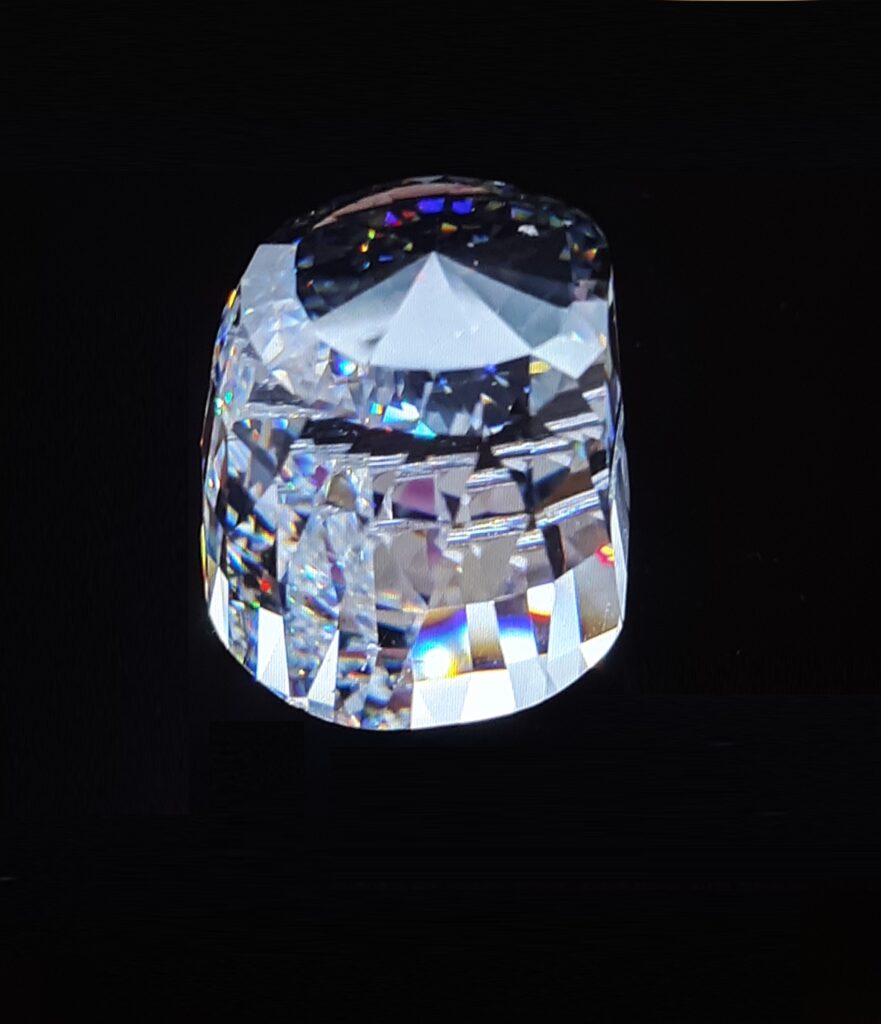
Specifications
Weight: Approx. 195 carats*
Dimensions: 34.92 x 31.75 x 24.6 mm*
Color: Colorless
Weight of Rough: Mogul, estimated 275.65 carats
Origin: India
Date Found: Cut from Mogul, c. 1680
Current Location: Russian Diamond Fund, Kremlin
*Derived from GemCad modeling.
Details
The Orlov is one of those ancient Indian stones surroundedby mystery and intrigue. It has no factually recorded beginning. Others write of mythsand fables concerning it, but there are no real facts until it was purchased byCount Orlov and given to Catherine the Great in 1772. Her royal scepter was designed by Troitinskyin 1784 (Twining, p. 534), and the stone has resided in it ever since.
The stone has a very complex facet pattern, difficult todiscern from the published photos of it. However, careful analysis of the photos combined with descriptions bythose that have seen it allow a fairly accurate model to be created. Access to the actual diamond and getting itlaser scanned for absolutely perfect data is somewhat problematic as the stone resides in the Russian Diamond Fund in the Kremlin.
Dimensions have been reported as 35x32x21 mm. Other sources say 47.6mm in height, 31.75 mm in width, and 34.92 mm in length. A bit of a discrepancy, but careful analysisof the photos shows that 34.92 x 31.75 x 24.6 is reality. As it has an irregular outline, these mayvary depending on how the stone is oriented when measured. If the stone is oriented so that the largestdimension is North-South, then the width East-West is 31.75 mm, matching whatthe Russian’s officially report. Thedepth varies as the diamond does not have a flat bottom, ranging from 24.6 to22.7 mm from scaled photos.
So, where did the stone originate? It is clearly of Indian origin, but there isno discovered record of it. From thephotos, it is easy to see how some have described it as half of an egg. This same description was given by Tavernierto a different diamond, the Mogul, adding “On the lower edge there is a slightcrack, and a little flaw in it.” (Ball, Vol I, p. 315).
Alexander Fersman, a noted Russian geologist and gemologist,studied the Orlov in 1922 and concluded that the Orlov was cut from the Mogul(Fersman, Russia’s Treasure of Diamonds and Precious Stones, in four parts, 1925-1926,Part 4, p. 10). This is logical, asdiamonds in the rough aren’t normally formed to make a final shape that takesthe form of “half of an egg”. Sincethese two diamonds share a similar description, and since the Mogul (279 cts) islarger than the Orlov (195 cts), it is logical to assume the smaller was cutfrom the larger. Others have reached thesame conclusion, but none has written of how that conclusion was reached. If this happened:
1. Is it physically possible for the Orlov to becut from the Mogul?
2. Why would it have been recut?
3. When would this have occurred?
In answering if the Orlov can be physically cutfrom the Mogul, limitations to modeling must first be understood. In the case of the Mogul, it is only mentioned once, and that is by Tavernier in 1676. He drew a picture that was used for modeling, and then scaled it to encompass his reported weight. Dimensions based on this information are 34.85 x 25.61 mm as calculatedfrom GemCad.

The final model can only be accurate if Tavernier’s drawing and reported weight were accurate. Line drawings are known to be subject to artistic interpretation and highly inaccurate (see the reference to the different Florentine and Sancy drawings throughout history as reported by Tillander). Tavernier’s drawing nor weight cannot be corroborated by any other known documentation, so there is some latitude in interpreting this minimal data.
Accurately modeling the Orlov is very difficult as there arethe before-mentioned differences in dimensions, plus the number of photographsto use for modeling are minimal. Thefinal computer model was created by overlaying the semi-transparent GemCadworkspace over the photographs and ensuring any digital cutting operationmatched all photos. The result is a veryaccurate match, and probably good enough for this discussion. However, only laser scanning can providetruly accurate measurements, and getting these is considered highly unlikelyconsidering the levels of security surrounding the diamonds in the RussianDiamond Fund.
Based on these limitations, the Orlov would appear to fit very nicely inside the Mogul based on dimensions and weight. From the top down, they appear to fit like a hand in a glove.
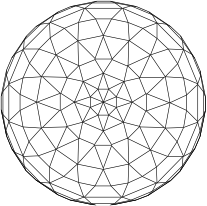
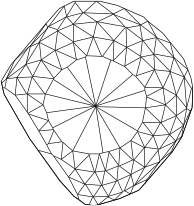

Figures 2a, 2b, 2c (top views)
But how well do they fit based on shape? A side-view comparison shows that the Orlov could NOT have been cut from the Mogul. Although the circumference of the Mogul completely encompasses the circumference of the Orlov, the latter has a much shallower top and as a result it “sticks out” from the Mogul model. So, do we have a contradiction to the history books?

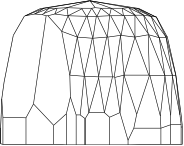
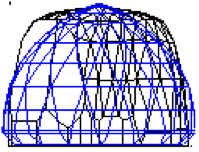
Figures 3a, 3b, 3c (side views)
I’m thinking not. A definitive contradiction requires both computer models to be absolutely accurate, which is shown to be impossible. The dimensions, shape, and weight of the Orlov should be considered the reference as those used here have been verified to be good enough for this discussion. Everything for the Mogul must be inferred. So what is more likely, the model of the Orlov or the Mogul being wrong? Clearly the Mogul. But how wrong can the Mogul model be? Can it be redesigned to completely engulf the Orlov and bear some resemblance to the historical description?
The difference in weights between the Mogul and Orlov amounts to approximately 89 carats (279-190). Can the 89 carats be added to the Orlov to rebuild a Mogul? The most obvious is adding material to the large flat area at the 8 o’clock position in Figure 2b. This could remove the flaws reported in the Mogul, making the Orlov more perfect in order to present to the Empress Catherine. This adds approximately 16 carats.
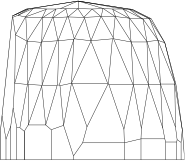
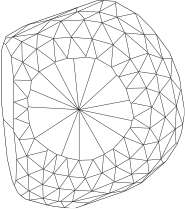
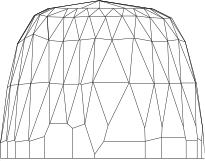
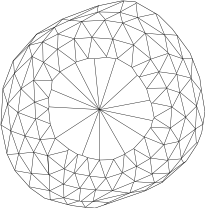
Figures 4a, 4b, 4c, 4d. Before and After Adding 16 Carats
A further review of Figure 4 shows additional flat spots at 10 and 4 o’clock, one of which would be created to remove the reported flaw. Adding the removed material, plus more material to the bottom of the Orlov to make a perfectly flat base for the Mogul, could easily make up any difference.
So is it probable that the Orlov was cut from the Mogul? If one is willing to acknowledge that Tavernier’s drawing is not accurate, it is very possible, and quite likely. Recut the Mogul to remove flaws and eventually call it the Orlov. There is no contradiction to history, the smaller was cut from the larger.
But when and why was this done? The geneology of both stones is difficult to determine as the Mogul has no definitive end and the Orlov no beginning. There are several versions of how one became the other, all lurid and involving murder and intrigue, but similar stories have been told for other notable diamonds. It would be highly unlikely they all started out as the eye in a Hindu statue, were spirited away in the dark of night, the original thief murdered, and the murderer eventually selling the stone somewhere in Europe.
Fersman states that the Mogul was discovered in the beginning of the 17th century in Golconda. “Its original weight was 300 carats. . . . Shah Jahan was unsatisfied with its cut, and insisted that it be re-cut, after which it assumed the form of the present Orlov, of approximately 200 metric carats.” (The original weight he refers to is obviously that of the cut Mogul, not the rough of the Mogul.) As the Mogul had flaws it is easy to see why Shah Jahan had it recut. Furthermore, “According to the legendary information of Pallas, the Orlov and Koh-i-noor were both set in the throne of Shah Nadir, who seized Delhi in 1737. The Orlov at this time was called Deryai-noor (Sea of Light); the other stone – Koh-i-noor (Mountain of Light).”
Fersman then states that Count Orlov acquired the diamond in 1772 in Amsterdam and shortly thereafter presented it to Catherine the Great. In 1784, she had the royal scepter created with the Orlov mounted at the top. It has remained there ever since.
This version makes sense and could possibly be corroborated by researching Russian records. It doesn’t explain how the diamond made it from Persia to Amsterdam (Fersman speculates it was stolen, maybe parts of the myths are accurate after all, maybe the secret is waiting to be discovered in historical records). What is more interesting is that the diamond at the time of acquisition was called the Darya-i-Noor. But there is another diamond known as the Darya-i-Noor in the Iranian treasury, a pale pink rectangular stone, which certainly does NOT match the description of the Orlov. This is a problem that must be resolved.
The Iranian DIN, the same one replicated and discussed on this web site, has a history traced via forensic evidence to Tavernier’s Great Table (see the section on the Great TAble). This is clearly NOT the DIN related in any way to the Orlov due to their difference in color. Interestingly, Sir Harford Brydges Jones, a British diplomat, went to Persia in 1791 at the request of the Shah and reported that he saw the Great Table and it was exactly as Tavernier reported it. However, he also reports it being called the Darya-i-Nur (Brydges, Dynasty of the Kajars, p. 137). Apparently “Great Table” is the Euro-centric name. The Iranians, who have owned it since Nadir Shah brought it back from India in 1739, have called it the Darya-i-Noor since then, and the larger part of the Great Table, when it was broken and recut, retained the name.
But wait, there’s more! When the British took over the Punjab in 1849, they acquired the Koh-i-Noor along with other notable jewels. Among them is a diamond called – – wait for it – – wait for it – – the Darya-i-Noor! This diamond is well documented (History of Koh-i-Noor, Darya-i-Noor, and Taimur’s Ruby, p. 101, ) in a series of notes between British government officials. This diamond was displayed at the Great Exhibition in 1851, so it certainly is not a mythical stone. It has changed hands several times since then, and its current location is reportedly in a vault in the Sonali Bank, Ltd., in Bangladesh (http://www.banglapedia.org/HT/D_0043.htm). As the Orlov has been in Russian hands since 1772, and the pink DIN in Iranian hands since 1739, it is not possible that either was displayed in the Great Exhibition. Now there’s a third DIN existing contemporaneously with the other two.
Does this prove/disprove that the Orlov was cut from the Mogul? It corroborates nothing but does point out the difficulty in tracing the early history of historic diamonds. Between Fersman calling the Orlov the DIN, the pink Iranian DIN, and the British now Bangladeshi DIN, there are three diamonds with the same name. And if the Orlov was called the DIN by Nadir Shah, he now has at least two stones, possibly three, all with the same name. This discrepancy could be resolved by researching any existing inventories of the booty carried back by Nadir Shah.
Ignoring the confusion, it seems that:
1. Tavernier’s Mogul was cut into a stone called the Darya-i-Noor somewhere around 1680 at the request of Shah Jahan as he didn’t like the flaws mentioned by Tavernier.
2. The DIN resides with Shah Jahan’s descendants until Nadir Shah takes it when he sacked Delhi in 1737. The diamond gets carried back to Persia.
3. In 1772 the diamond is in Amsterdam where it is purchased by Count Orlov and is now called the Orlov diamond.
4. The diamond was set in the royal scepter in 1784 where it has resided ever since.
